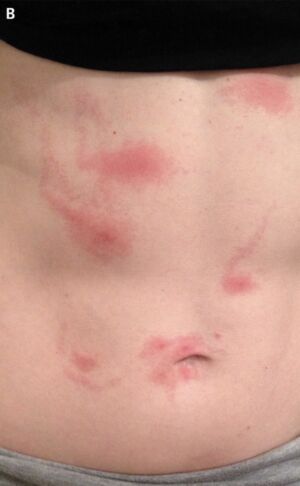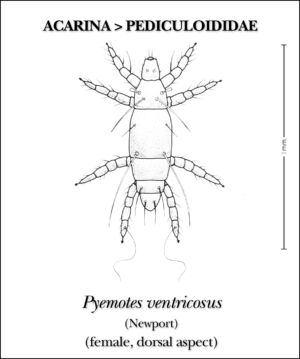
A couple in France developed a rare, "almost forgotten" disease after the beetles munching on their furniture developed their own infestation of toxin-toting mites, according to a case report published in the New England Journal of Medicine by doctors in Marseille.
The man and woman, both 30 years old, turned up at an infectious disease clinic three days after developing an intensely itchy rash all over their abdomens. The cause may have easily gone undetermined if it weren't for a telltale pattern of the woman's rash—the itchy pink marks on her trunk had central dots with pink trails reminiscent of a comet.

P. ventricosus is an ectoparasites of the common furniture beetle, Anobium punctatum, a wood-boring beetle that devours wood-based furniture and structures. The mites have a truly disturbing life cycle on their chosen hosts. When a female bites a beetle larva, it injects a toxin to paralyze its prey, then sucks up its meal, engorging itself. The feeding allows the female to nourish up to 300 eggs in her abdomen, which fully develop there. A few days after the feeding, the female gives birth to adult mites that immediately mate and disperse to find new hosts, starting the process again. The males are not visible to the unaided eye, and the females can only barely be seen if they're engorged
If there aren't enough beetles to feast upon, the mites will inadvertently bite mammals, such as horses, cattle, and humans. The mites can't use these animals as hosts, but it doesn't make their bites any less horrifying. In humans, the painless bites by the seemingly invisible mites develop over the course of about 24 hours into extremely itchy welts and pink marks. It's not entirely clear what causes the comet sign, but it's thought to be due to inflammation of a lymphatic channel around the bite.
“Almost forgotten”
Mites in the family Pyemotidae can parasitize a variety of insects and can be found in seeds, grain, straw, as well as wood, but such reports of Pyemotes dermatitis have popped up sporadically for well over a century. Pyemotes ventricosus was first described in 1850, though the first reported outbreak was only reported in 1909 among the crew of a private yacht, who slept on infested straw mattresses.
Since then, there have been just around 20 outbreaks, according to a review published last year, as well as about 40 individual case reports.

Another outbreak occurred in 2017 in Poland among workers at an herbal medicine company. The main explanation for the outbreak was that the company had switched the time of year that it handled one particular herb (Helichrysum arenarium). Before 2017, the herb was only processed during the winter, but was processed that year in the summer, when the mites are most active. "This resulted in the reemergence of an almost forgotten disease," the outbreak report authors wrote, stressing the "importance of examining environmental specimens for ectoparasites in cases of unexplained dermatoses." In fact, almost all of the cases and outbreaks reported in the scientific literature occur between May and November.
The good news is that however gross and itchy, the mite bites are rare and not thought to transmit infectious diseases. The skin condition generally resolves on its own, though sometimes it can be accompanied by fever, chills, vomiting, and headaches, depending on how extent of the mite attack.
In the couple's case, they ditched their infested furniture and were treated with topical glucocorticoids and antihistamines. Their itchy lesions went away eight days later.
reader comments
61